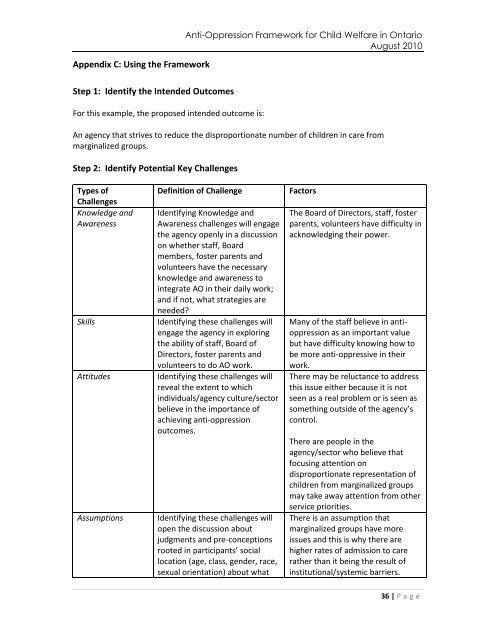An Anti-Oppression Framework for Child Welfare in Ontario
An Anti-Oppression Framework for Child Welfare in Ontario
An Anti-Oppression Framework for Child Welfare in Ontario
You also want an ePaper? Increase the reach of your titles
YUMPU automatically turns print PDFs into web optimized ePapers that Google loves.
Appendix C: Us<strong>in</strong>g the <strong>Framework</strong><strong>An</strong>ti-<strong>Oppression</strong> <strong>Framework</strong> <strong>for</strong> <strong>Child</strong> <strong>Welfare</strong> <strong>in</strong> <strong>Ontario</strong>August 2010Step 1: Identify the Intended OutcomesFor this example, the proposed <strong>in</strong>tended outcome is:<strong>An</strong> agency that strives to reduce the disproportionate number of children <strong>in</strong> care frommarg<strong>in</strong>alized groups.Step 2: Identify Potential Key ChallengesTypes ofChallengesKnowledge andAwarenessSkillsAttitudesAssumptionsDef<strong>in</strong>ition of ChallengeIdentify<strong>in</strong>g Knowledge andAwareness challenges will engagethe agency openly <strong>in</strong> a discussionon whether staff, Boardmembers, foster parents andvolunteers have the necessaryknowledge and awareness to<strong>in</strong>tegrate AO <strong>in</strong> their daily work;and if not, what strategies areneeded?Identify<strong>in</strong>g these challenges willengage the agency <strong>in</strong> explor<strong>in</strong>gthe ability of staff, Board ofDirectors, foster parents andvolunteers to do AO work.Identify<strong>in</strong>g these challenges willreveal the extent to which<strong>in</strong>dividuals/agency culture/sectorbelieve <strong>in</strong> the importance ofachiev<strong>in</strong>g anti-oppressionoutcomes.Identify<strong>in</strong>g these challenges willopen the discussion aboutjudgments and pre-conceptionsrooted <strong>in</strong> participants’ sociallocation (age, class, gender, race,sexual orientation) about whatFactorsThe Board of Directors, staff, fosterparents, volunteers have difficulty <strong>in</strong>acknowledg<strong>in</strong>g their power.Many of the staff believe <strong>in</strong> antioppressionas an important valuebut have difficulty know<strong>in</strong>g how tobe more anti-oppressive <strong>in</strong> theirwork.There may be reluctance to addressthis issue either because it is notseen as a real problem or is seen assometh<strong>in</strong>g outside of the agency’scontrol.There are people <strong>in</strong> theagency/sector who believe thatfocus<strong>in</strong>g attention ondisproportionate representation ofchildren from marg<strong>in</strong>alized groupsmay take away attention from otherservice priorities.There is an assumption thatmarg<strong>in</strong>alized groups have moreissues and this is why there arehigher rates of admission to carerather than it be<strong>in</strong>g the result of<strong>in</strong>stitutional/systemic barriers.36 | P a g e
















